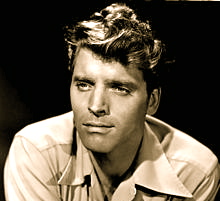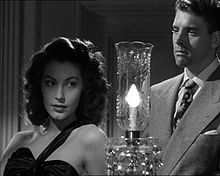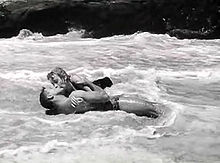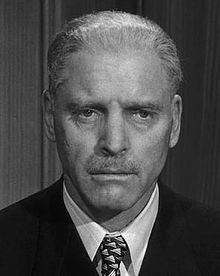Burt Lancaster

Burt Lancaster profile on TCM

Narrated by John Frankenheimer, this is an excellent brief little profile of actor Burt Lancaster, presented on TCM (Turner Classic Movies). It gives you a pretty good overview of this wonderful actor’s career. Clips from many Lancaster films, including “Elmer Gantry,” “The Seven Days in May,” “Sweet Smell of Success,” and “Birdman of Alcatraz.”
in Desert Fury (1947)
Burton Stephen “Burt” Lancaster (November 2, 1913 – October 20, 1994) was an American film actor noted for his athletic physique, blue eyes and distinctive smile (which he called “The Grin”). After initially building his career on “tough guy” roles Lancaster abandoned his “all-American” image in the late 1950s in favor of more complex and challenging roles, and came to be regarded as one of the best actors of his generation as a result.
Lancaster was nominated four times for Academy Awards and won once — for his work in Elmer Gantry in 1960. He also won a Golden Globe for that performance and BAFTA Awards for The Birdman of Alcatraz (1962) and Atlantic City (1980). His production company, Hecht-Hill-Lancaster, was the most successful and innovative star-driven independent production company in Hollywood of the 1950s, making movies such as Marty (1955), Trapeze (1956), and Sweet Smell of Success (1957).
In 1999, the American Film Institute named Lancaster 19th among the greatest male stars of all time.
Early life
Lancaster was born in Manhattan, New York City, at his parents’ home at 209 East 106th Street, between Second and Third Avenues, today the site of Benjamin Franklin Plaza. Lancaster was the son of Elizabeth (née Roberts) and James Henry Lancaster, who was a postman.[2] Both of his parents were Protestants of working-class origin. Lancaster’s maternal grandparents were immigrants to the U.S. from Belfast and descendants of English immigrants to Ireland.[2] The family believed themselves to be related to Frederick Roberts, 1st Earl Roberts. Lancaster grew up in East Harlem and spent much of his time on the streets, where he developed great interest and skill in gymnastics while attending the DeWitt Clinton High School, where he was a basketball star. Before he graduated from DeWitt Clinton, his mother died of a cerebral hemorrhage. Lancaster was accepted into New York Universitywith an athletic scholarship but subsequently dropped out.
Circus career and military
At the age of nine, Lancaster met Nick Cravat, with whom he continued to work throughout his life. Together they learned to act in local theater productions and circus arts at Union Settlement, one of the city’s oldest settlement houses. They formed the acrobat duo “Lang and Cravat” and soon joined the Kay Brothers circus. However, in 1939 an injury forced Lancaster to give up the profession, with great regret. He then found temporary work until 1942 — first as a salesman for Marshall Fields, and then as a singing waiter in various restaurants.
The United States having then entered World War II, Lancaster joined the United States Army and performed with the Army’s Twenty-First Special Services Division, one of the military groups organized to follow the troops on the ground and provide USO entertainment to keep up morale. He served with General Mark Clark’s Fifth Army in Italy from 1943–1945.
Film career – Acting
 With Ava Gardner in The Killers (1946)
With Ava Gardner in The Killers (1946)
Though initially unenthusiastic about acting, he returned from service, auditioned for a Broadway play, and was offered a role. Although Harry Brown‘s A Sound of Hunting was not successful, Lancaster’s performance drew the attention of a Hollywood agent, Harold Hecht, who introduced him to Hal Wallis, who cast Lancaster in The Killers (1946). (Hecht and Lancaster later formed several production companies in the 1950s to give Lancaster greater creative control.) The tall, muscular actor won significant acclaim and appeared in two more films the following year. Subsequently, he played in a variety of films, especially in dramas, thrillers, and military and adventure films. In two, The Flame and the Arrow and The Crimson Pirate, a friend from his circus years, Nick Cravat, played a key supporting role, and both actors impressed audiences with their acrobatic prowess.
 With Deborah Kerr in From Here to Eternity (1953)
With Deborah Kerr in From Here to Eternity (1953)
In 1953, Lancaster played one of his best remembered roles with Deborah Kerr in From Here to Eternity. The American Film Institute acknowledged the iconic status of the scene from that film in which he and Deborah Kerr make love on a Hawaiian beach amid the crashing waves. The organization named it one of “AFI’s top 100 Most Romantic Films” of all time.
Lancaster won the 1960 Academy Award for Best Actor, a Golden Globe Award, and the New York Film Critics Award for his performance in Elmer Gantry.
In 1966, at the age of 52, Lancaster appeared nude in director Frank Perry‘s film, The Swimmer.
During the latter part of his career, Lancaster left adventure and acrobatic movies behind and portrayed more distinguished characters. This period brought him work on several European productions, with directors such as Luchino Visconti and Bernardo Bertolucci. Lancaster sought demanding roles, and if he liked a part or a director, he was prepared to work for much lower pay than he might have earned elsewhere. He even helped to finance movies whose artistic value he believed in. He also mentored directors such as Sydney Pollack and John Frankenheimer and appeared in several television films. Lancaster’s last film was Field of Dreams (1989).
For his contribution to the motion picture industry, Lancaster has a star on the Hollywood Walk of Fame at 6801 Hollywood Boulevard.
Frequent collaborations
Apart from acting in a total of seventeen films produced by Harold Hecht, Lancaster also appeared in eight films produced by Hal B. Wallis.
Lancaster made six films over the years with Kirk Douglas, including I Walk Alone (1948), Gunfight at the O.K. Corral (1957), The Devil’s Disciple (1959), The List of Adrian Messenger (1963), Seven Days in May (1964), and Tough Guys (1986) which fixed the notion of the pair as something of a team in the public imagination. The connection was firmly cemented by the time Lancaster and Douglas reteamed for their final movie, Tough Guys. Although Douglas was always second billed under Lancaster in these films, their roles were usually more or less the same size with the exceptions of I Walk Alone, in which Douglas played a villain, and in Seven Days in May, where Douglas’ part was larger than Lancaster’s but not as dramatic.
 in Judgement at Nuremberg (1961)
in Judgement at Nuremberg (1961)
Lancaster also often asked his close friend Nick Cravat to appear in his films. They co-starred together in nine films: The Flame and the Arrow (1952), Ten Tall Men (1951), The Crimson Pirate(1952), Run Silent, Run Deep (1958), The Scalphunters (1968), Airport (1970), Valdez Is Coming(1971), Ulzana’s Raid (1972), The Midnight Man (1974), and The Island of Dr. Moreau (1977).
Lancaster starred in three films with Deborah Kerr; From Here to Eternity, Separate Tables, and The Gypsy Moths.
In addition, John Frankenheimer directed five films with Lancaster: The Young Savages (1961),Birdman of Alcatraz (1962), Seven Days in May (1964), The Train (1964), and The Gypsy Moths(1969).
Lancaster used make-up veteran Robert Schiffer in 20 credited films. Lancaster hired Schiffer on nearly all the films he produced.
Personal life – Marriages and relationships
Lancaster vigorously guarded his private life. He was married three times. His first two marriages ended in divorce — to June Ernst from 1935 to 1946, and to Norma Anderson from 1946 to 1969. His third marriage, to Susan Martin, was from September 1990 until his death in 1994. All five of his children were with Norma Anderson: Bill, who became a screenwriter; James; Susan; Joanna; and Sighle (pronounced Sheila). He claimed he was romantically involved with Deborah Kerr during the filming of From Here to Eternity in 1953. However, Kerr stated that while there was a spark of attraction, nothing ever happened. He also had an affair with Joan Blondell. In her 1980 autobiography, Shelley Winters claimed to have had a long affair with him.
Political views
Lancaster was a vocal supporter of liberal political causes, and frequently spoke out in support of racial minorities, including at the March on Washington in 1963. He was a vocal opponent of the Vietnam War and political movements such as McCarthyism, and he helped pay for the successful defense of a soldier accused of “fragging” (murdering) another soldier during the war. In 1968, Lancaster actively supported the presidential candidacy of antiwar Senator Eugene McCarthy of Minnesota, and frequently spoke on his behalf during the Democraticprimaries. He heavily campaigned for George McGovern in the 1972 presidential election. In 1985, Lancaster, a longtime supporter of gay rights, joined the fight against AIDS after his close friend, Rock Hudson, contracted the disease. He campaigned for Michael Dukakis in the 1988 presidential election.
Health problems and death
As Lancaster grew older, he became increasingly plagued by atherosclerosis, barely surviving a routine gall bladder operation in January 1980. Following two minor heart attacks he had to undergo an emergency quadruple heart bypass in 1983, after which he was extremely weak, but he still managed to attend a 1988 Congressional hearing with old colleagues such as Jimmy Stewart and Ginger Rogers to protest media magnate Ted Turner‘s plan to colorize various black-and-white films from the 1930s and 1940s. A severe stroke in November 1990 left him partly paralyzed and largely unable to speak. He died in his Century City apartment in Los Angeles from a third heart attack at 4:50 A.M. on October 20, 1994 at the age of 80.
Lancaster was cremated and his ashes were buried under a large oak tree in Westwood Memorial Park located in Westwood Village, Los Angeles County, California. A small square ground plaque inscribed only with “BURT LANCASTER 1913-1994” marks his final resting place. Upon his death, as he requested, he had no memorial or funeral service.



